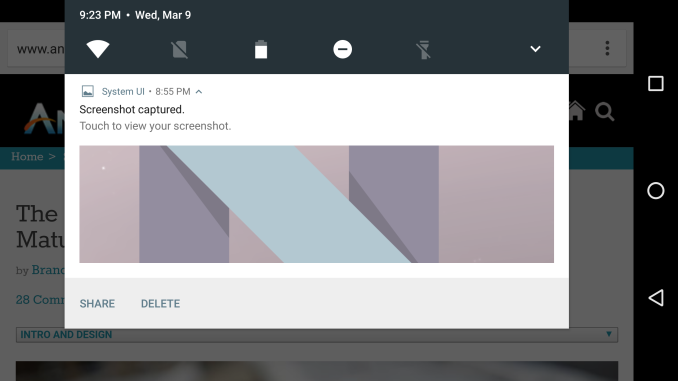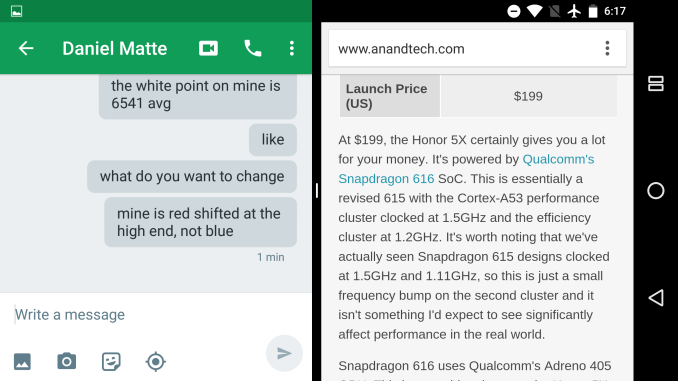Hands-On With the Android N Developer Beta: Multi-Window & More
by Brandon Chester on March 10, 2016 8:00 AM EST- Posted in
- Smartphones
- Android
- Mobile
- Tablets
Initial Impressions
Though I suspect it's not a popular opinion, I have long felt that the software design ecosystem for Android tablets has been stuck in a rut since the early days, and as a result users have struggled to find good, modern applications that really excel at the tablet experience. Android N can't magically bring proper tablet interfaces to all Android apps, but the Multi-Window support is a big help in improving the situation. With split windows in use, on a standard tablet you're really dealing with a screen segmented into two areas, and this is where a phone layout works pretty well. With that in mind, it does help to address the problems that Android tablets currently face, but I do hope that developers will continue to maintain existing tablet UIs, and that new developers will take the time to create ones. I don't know if Google's internal app development groups are prepared for this, but I have faith in the larger Android's developer community.
It's worth noting that the Multi-Window mode technically also works on phones. That said, unless you have a 6.8" phone (which is practically a tablet), I don't think the feature is very useful, but it's there. Even on the Nexus 6 there's just not enough screen space, and I would never use it myself. That said, while I was initially ttempted to recommend that Google just remove the feature on phones, on reflection it doesn't really hurt anyone to have it there for users that want it. On top of that, leaving it to tablets alone may cause some developers to just not support the feature entirely.
Google also has an advantage with Android apps already being designed to support many resolutions and aspect ratios. Several apps that I tried already worked with the split screen mode, and developers aren't going to have to rebuild their UIs like they did when Apple introduced split screen multitasking on iOS. In fact, it's most certainly the case that there are more apps that work with Android N's multitasking than there are that work with multitasking on the iPad, and considering that the feature just launched today in a beta OS I'd say that's a big win for Google and for Android.
If I were to make any recommendations for Google, it would be to make it a bit more obvious to the user that you can hold down the multitasking button inside an app to instantly get into split view mode. I happened to come across it because I figured that Google would have implemented some sort of quick access method, but it's not obvious enough for your average user. In addition, I think the current method of simply filling the view with the background color as you adjust the ratio between apps is not very aesthetically pleasing. These apps still aren't really designed to adjust their UI in real time, and although it's somewhat lame to just blur it out like Apple does on iOS, it looks better than watching the UI frantically try to fill the space.

Quick toggles are easier to access in Android N
As for Google's other changes, I think they're in line with what we've come to expect. After Lollipop, Google was able to step back and focus on the lower level problems with their platform, particularly regarding efficiency. The improvements to Doze will certainly have an impact on energy usage, and blocking apps from waking up in large numbers whenever the phone goes on or off of WiFi is a smart move. I expect that we'll see continued improvement of this sort in future Android releases, as problems with energy management are potentially the biggest problem plaguing the platform right now, with performance and usability having been mostly sorted out. These releases also provide a way for Google to make small improvements to areas like notifications and their built in applications to make the user experience a lot better through many little changes.
On that note, I'm sure many of our more technical readers are interested in being part of the beta. I'm very happy that Google has taken the necessary steps to make the process of enrolling in the program much easier for developers and users. Right now the supported devices include the Pixel C, Nexus 9, Nexus 5X, Nexus 6, Nexus 6P, and Nexus Player. To enroll your device in the beta you can visit this link and your device will quickly notify you that an update is available. It does need to be reiterated that this is a developer beta and a true beta at that - it's not a large-stage end-user beta - but I would encourage enthusiasts who do enroll to consider sending some feedback to Google about what they like and what could be improved, as that's ultimately what these beta programs are all about.
One last thing to note is Google's incentive for developers to test their apps on tablets so they can ensure proper Multi-Window support. For a limited time developers can sign up here to get a promo code which will knock 25% off the cost of the Google Pixel C. With Google recently having patched the most serious bugs on the Pixel C, for $375 it's a pretty good tablet and a very good device for doing application testing considering the fact that the Android N beta only works on two tablets. Interested developers can sign up here, and Google is seemingly taking people on faith that they really do intend to use the unit for development as it only involves entering your email address.
With Android N being in its early stages, I must say that I'm impressed with the stability and usability of the features that Google has added. With Google IO on the horizon we'll certainly be hearing more about what's coming in Android N, and I'm very excited about the direction Google is headed in.












124 Comments
View All Comments
Brandon Chester - Thursday, March 10, 2016 - link
Swiping down from the top of the display to past the middle with two separate fingers is not very useful when you're holding the phone in one hand.serendip - Thursday, March 10, 2016 - link
Having used an iPad and a Windows 10 tablet with the split screen mode, I'm not convinced that it's useful on tablets smaller than 10". You end up getting squeezed layouts for both apps. It's better to have a single fullscreen app that shows data properly, even with the mental context switch needed when switching apps.I would prefer small applets that pop over the current app, like a quick chat window or a calendar view. That saves time instead of having to fire up another app.
Maybe Google should map a button to go back to the previous app, like Alt-Tab. I have this custom config on my phablet with CM12 and it feels almost as fast as multitasking on a desktop OS.
Gobbmeister - Friday, March 11, 2016 - link
Doesn't double tapping the overview button switch to the previous app like Alt-Tab in Windows?serendip - Thursday, March 10, 2016 - link
Horses for courses. I hate my Android tablet with a passion because Google hasn't done much to use all that screen real estate. My Windows 10 tablet is fast, has good battery life and runs desktop Windows programs - but the quality and number of Modern touch apps is seriously lacking. I use it mainly as a tiny laptop when I travel.My Android phablet is still my go-to device for 90% of my daily computing. I don't want splits screens on a small 5.5" screen but I do want a fast way of switching apps.
jospoortvliet - Friday, March 11, 2016 - link
I can't speak for the WiFi API but removal of the API to notify of photos taken is pretty stupid. Say you use ownCloud and have it set to upload pictures you take to your server (almost everybody wants this - dropbox and Google Drive offer similar functionality). Now on Apple iOS there is no notification for this so apps have to use tricks like listening to GPS events instead and then check for new pictures - often checking while nothing is new, wasting power. On android there was no need to waste power: only upload what is new when you get notified. Why in $DEITY's name does Google think removal of this API will SAVE power?jospoortvliet - Friday, March 11, 2016 - link
I can't speak for the WiFi API but removal of the API to notify of photos taken is pretty stupid. Say you use ownCloud and have it set to upload pictures you take to your server (almost everybody wants this - dropbox and Google Drive offer similar functionality). Now on Apple iOS there is no notification for this so apps have to use tricks like listening to GPS events instead and then check for new pictures - often checking while nothing is new, wasting power. On android there was no need to waste power: only upload what is new when you get notified. Why in $DEITY's name does Google think removal of this API will SAVE power?tuxRoller - Friday, March 11, 2016 - link
Another big change they made is to include a jit along with the aot. The jit is used almost exclusively for gathering profile data during app usage so the aot can use pgo during downtimes. This is apparently something that is continually happening with an eye on two optimizations: execution efficiency and memory size.UtilityMax - Saturday, March 12, 2016 - link
The interest in tablets is so low because for most people, a tablet is their third device at best, after a notebook and a smartphone. Tablet is lousy for productivity work because with no keyboard, or with tiny keyboard, it's clumsy to work on. Yet, it's big enough that you won't carry it in your pocket all the time, like you can the smartphone. Even with better multitasking, I find it hard to believe that being able to split a small 8-10 inch screen into separate app areas will really find a killer application.For me, the number one tablet uses are web browsing, reading, or being a portable tv/streaming screen. And for those, the current apps seem to work pretty well (my favorites are adblock browser, uverse, netflix, and the MX Player).
Alexvrb - Tuesday, March 15, 2016 - link
I don't think the scenario you're describing applies to everyone. But if you fall into such a category, why not use a 2-in-1 that covers both tablet and notebook usage?Badelhas - Tuesday, March 15, 2016 - link
I am very interested in Doze mode when the screen is off but not stationary but I guess I wont be seeing any of that on my aging but still great HTC M8...